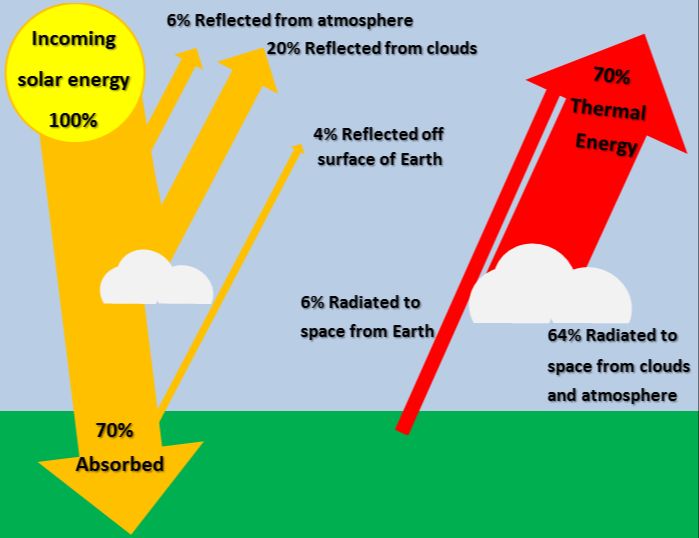How Much Solar Energy Is Reaching Earth?

Solar energy refers to the light and heat that comes from the Sun. Understanding how much of this solar energy is reaching Earth is important for several reasons. First, solar energy drives many processes on Earth, from weather patterns to photosynthesis. Knowing the amount and variation of solar energy informs our understanding of climate and biological processes. Second, solar energy is increasingly used to generate electricity through photovoltaics and concentrated solar power. Accurately measuring solar irradiance enables proper design and performance modeling for these technologies. Finally, tracking changes in the amount of solar energy reaching Earth can provide insights into solar cycles and activity.
This article will provide an overview of how much solar energy is reaching Earth. Topics covered include the Sun’s energy output, definitions of solar irradiance, natural effects that influence irradiance levels, measurement techniques and instrumentation, the total solar irradiance reaching Earth, regional differences in irradiance, and future projections for solar availability.
The Sun’s Energy Output
The Sun produces enormous amounts of energy that radiate out into space. The total solar irradiance, or solar luminosity, refers to the amount of solar energy output from the Sun that reaches 1 astronomical unit (the distance from the Earth to the Sun). According to Perry et al. (2000), the total solar irradiance is approximately 1361 watts per square meter (W/m2), with variations of around 0.1% over timescales of days to months.
The Sun’s luminosity is not constant and experiences cycles of higher and lower energy output. As summarized by Domingo (1979), measurements of solar luminosity from satellites indicate the total irradiance fluctuates by around 0.1% over the course of the approximately 11-year solar cycle. The maximum occurs during periods of increased solar activity when the Sun has many sunspots and solar flares.
Multiple studies have measured and confirmed that the fluctuations in total solar irradiance correlate to changes in sunspot numbers and overall solar activity (see Perry et al., 2000, Domingo, 1979, and Stauning, 2011). This variable energy output is an important factor in solar-terrestrial interactions.
Solar Irradiance
Solar irradiance is a measure of the intensity of solar power over a given area that is exposed to sunlight. It refers to the rate at which solar energy is received per unit area on the Earth’s surface or at the top of the atmosphere (TOA). Solar irradiance is typically expressed in watts per square meter (W/m2).
At the TOA, the solar irradiance is about 1,361 W/m2, averaged over the year and across varying distances between the Earth and Sun throughout the year. This measurement is known as the solar constant. At the Earth’s surface, the solar irradiance is reduced due to reflection, scattering, and absorption of sunlight in the atmosphere. The average irradiance at the surface is around 1,000 W/m2 but this varies significantly depending on location, time of day, season, and local weather conditions.
Measuring and tracking solar irradiance is important for solar energy applications, climate research, and understanding Earth’s energy budget and climate system. Variations in irradiance can impact the efficiency of solar panels and affect climate patterns.
Effects on Irradiance
The solar irradiance that reaches the Earth’s surface is affected by the atmosphere. According to the U.S. Department of Energy, atmospheric conditions can reduce direct beam radiation by 10% on clear, dry days and by 100% during thick, cloudy days (Solar Radiation Basics). The atmosphere scatters and absorbs solar radiation through phenomena like clouds, fog, rain, snow, dust, and gas molecules. These effects can reduce the amount of direct irradiance reaching the surface.
The atmosphere has different effects depending on latitude, altitude, weather, and time. According to PVEducation.org, seasons cause regular variations in irradiance due to the change in distance between the Earth and the Sun throughout the year as well as the tilt of the Earth’s axis (Atmospheric Effects). Geography also impacts irradiance because higher latitude locations receive less direct radiation per unit area on average than lower latitude locations. Local weather patterns like cloud cover and precipiation cause irregular short-term fluctuations.
Measuring Irradiance
Accurately measuring solar irradiance reaching Earth’s surface is crucial for solar energy applications, weather forecasting, and climate research. However, irradiance measurement comes with several challenges.
Irradiance is measured using pyranometers, which are sensors that quantify broadband solar radiation flux density in watts per square meter. Pyranometers must meet ISO 9060 standards for spectral sensitivity, temperature response, tilt response, and other factors to ensure high accuracy (NREL). Maintaining calibration is also essential.
One key challenge is that pyranometers read direct and diffuse radiation, but not the circumsolar component around the sun’s disc, leading to measurement uncertainties especially at sunrise and sunset (PES). High aerosol loads, cloud enhancement, and complex terrain further complicate measurements.
To address these issues, researchers are exploring improved pyranometer designs, complementary instruments like pyrheliometers and sky imagers, and data quality control techniques. Obtaining accurate irradiance data is critical for reducing uncertainties in solar resource assessments and performance modeling.
Total Irradiance Reaching Earth
The total solar irradiance (TSI) is a measure of the total solar power per unit area incident on the Earth’s upper atmosphere. According to measurements from NASA’s Total Irradiance Monitor (TIM) instrument on the Solar Radiation and Climate Experiment (SORCE) satellite, the TSI currently reaching the top of Earth’s atmosphere is around 1361 watts per square meter (W/m2) 1. This value is known as the solar constant.
At Earth’s surface, the global average solar irradiance is approximately 1000 W/m2, taking into account absorption and reflection by the atmosphere 2. However, this value varies significantly based on location, time of day, season, and weather conditions. Solar irradiance at the surface can range from nearly zero at night to peaks of 1100 W/m2 on clear days in the tropics.
Regional Differences
Solar irradiance varies across different regions of the Earth due to several factors like latitude, seasons, and local weather. According to a 2019 study published in Solar Energy, there are clear continental-scale variations in solar irradiance [1]. During winter months, solar irradiance decreases predominantly with increasing latitude as the sun rises lower in the sky. During summer months, longitudinal variations become more prominent as areas farther west receive more direct sunlight due to Earth’s rotation.
In general, tropical regions near the equator receive the highest level of solar irradiance due to a more direct angle of sunlight. For example, annual average solar irradiance in Singapore is around 1,530 kWh/m2 compared to around 1,000 kWh/m2 in Berlin, Germany at 52°N latitude [2]. Desert areas such as the Sahara in Africa or the American Southwest see very high solar irradiance levels due to consistent sunny conditions.
Regional weather patterns also impact solar irradiance significantly. Cloudier regions receive lower irradiance levels compared to sunny areas. Elevation, pollution levels, and seasonal monsoons can all contribute to localized differences. Understanding these regional variations allows better predictions of solar energy potential across the world.
Future Projections
Future projections of total solar irradiance (TSI) reaching Earth have significant implications for understanding climate change. According to research by Sedlacek et al. (2022), two primary scenarios for future TSI have been proposed for climate modeling efforts like CMIP6. The first scenario projects TSI will continue its observed negative trend, decreasing by 0.25 W/m2 by 2100. However, the second TSI scenario assumes solar activity and TSI will recover to levels similar to the past several decades, only decreasing by 0.05 W/m2 by 2100. These diverging solar scenarios create differences in projected global warming of 0.2 to 0.3°C by 2100. Thus, uncertainty around future solar irradiance impacts climate change projections. Most research indicates TSI will likely continue decreasing slowly this century due to observed long-term changes in solar activity. But natural solar variability can cause unpredictable fluctuations in irradiance. Continued monitoring and modeling of TSI will be critical for narrowing climate projections and planning mitigation and adaptation strategies.
Impacts and Applications
Knowing the amount of solar irradiance reaching Earth has many important impacts and applications. Solar irradiance provides nearly all the energy that drives the Earth’s climate system and is a fundamental factor influencing Earth’s temperature and climate. Measurements of solar irradiance are vital for climate change research and modeling future climate scenarios (Total solar irradiance’s effect on the performance of photovoltaic modules).
Solar irradiance data is also crucial for solar power generation. Understanding the available solar resource at a location enables proper sizing and siting of solar photovoltaic systems. Solar irradiance measurements help predict the potential power output of photovoltaic systems (Solar radiation: what it is and how it is produced). Knowledge of the solar resource available, combined with weather data, allows for maximizing system performance.
In agriculture, measurements of solar irradiance inform greenhouse design and operations, helping optimize plant growth. The study of solar irradiance also has implications for human health, as excessive exposure can damage skin and eyes (Solar irradiance). Overall, quantifying solar irradiance reaching Earth has many critical real-world impacts across climate science, renewable energy, agriculture, and health fields.
Conclusion
The amount of solar energy reaching Earth is immense, averaging around 174 petawatts. This solar irradiance drives climate, weather, seasons, photosynthesis, and more. While the Sun’s output is relatively stable, small variations in solar irradiance can impact Earth’s climate over time. Understanding and accurately measuring the amount of incoming solar radiation is crucial for modeling Earth’s energy budget and climate. Regional differences in solar irradiation also impact ecosystems and energy resources. Overall, the vast amount of solar energy Earth receives makes it a vital renewable energy source, but also one that needs measured and modeled carefully to understand its effects on our planet.







